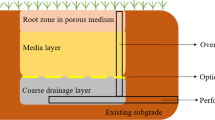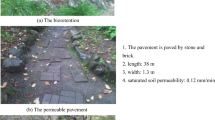Abstract
Understanding how low impact development approaches (LIDs) reduce urban stormwater runoff and increase baseflow is significant for urban water resources management. The SCS model and baseflow equation were employed to evaluate the performance of green roofs (GRs), permeable pavement (PP) and rain barrels (RBs) as retrofitting technologies in a high-density residential community in Nanjing, China. In addition, the factors relevant to the performance of LIDs were explored by estimating runoff variations at different rainfall frequencies. The findings are that the application of GR, PP and RB resulted in reduction in surface runoff by 0.6–36.8 % and increased in baseflow by 2.68–60.93 × 103 m3. In addition, there is a negative linear correlation between runoff depth and effective storage, and the effectiveness of RB on runoff reduction is greater than that of PP. The baseflow generated by 100 % LID implementation is 1.94 times greater than that generated by 50 % LID implementation. For PP, generated baseflow increased with the increase in effective storage. The baseflow generated by GR is 1.16 times greater than that generated by RB in the same roof area.







Similar content being viewed by others
References
Ahiablame LM, Engel BA, Chaubey I (2012) Effectiveness of low impact development practices: literature review and suggestions for future research. Water Air Soil Pollut 223:4253–4273. doi:10.1007/s11270-012-1189-2
Ahiablame LM, Chaubey I, Engel BA, Cherkauer K, Merwade V (2013a) Estimation of annual baseflow at ungauged sites in Indiana USA. J Hydrol 476:13–27. doi:10.1016/j.jhydrol.2012.10.002
Ahiablame LM, Engel BA, Chaubey I (2013b) Effectiveness of low impact development practices in two urbanized watersheds: retrofitting with rain barrels/cistern and porous pavement. J Environ Manag 119:151–161. doi:10.1016/j.jenvman.2013.01.019
Bedan ES, Clausen JC (2009) Stormwater runoff quality and quantity from traditional and low impact development watersheds. J Am Water Resour Assoc 45:998–1007. doi:10.1111/j.1752-1688.2009.00342.x
Burns MJ, Fletcher DT, Walsh J, Ladson AR, Hatt BE (2012) Hydrologic shortcomings of conventional urban stormwater management and opportunities for reform. Landsc Urban Plan 105:230–240. doi:10.1016/j.landurbplan.2011.12.012
Carter TL, Rasmussen TC (2006) Hydrologic behavior of vegetated roofs. J Am Water Resour As 42:1261–1274. doi:10.1111/j.1752-1688.2006.tb05299.x
Damodaram C, Giacomoni MH (2010) Simulation of combined best management practices and low impact development for sustainable stormwater management. J Am Water Resour As 46:907–918. doi:10.1111/j.1752-1688.2010.00462.x
Dewan AM (2013) Floods in a megacity: geospatial techniques in assessing hazards, risk and vulnerability. Springer Geography, pp 17–20. doi:10.1007/978-94-007-5875-9
Dietz MF (2007) Low impact development practices: a review of current research and recommendations for future directions. Water Air Soil Pollut 186:351–363. doi:10.1007/s11270-007-9484-z
Drake J, Bradford A, Van Seters T (2014) Hydrologic performance of three partial-infiltration permeable pavements in a cold climate over low permeability soil. J Hydrol Eng 19:04014016. doi:10.1061/(ASCE)HE.1943-5584.0000943
Fassman E, Blackbourn S (2010) Urban runoff mitigation by a permeable pavement system over impermeable soils. J Hydrol Eng 15:475–485. doi:10.1061/(ASCE)HE.1943-5584.0000238
Gao C, Liu J, Cui H, Hu J (2013a) Treatment of pump drainage boundary in riverside city. Environ Earth Sci 68:1435–1442. doi:10.1007/s12665-012-1841-6
Gao C, Liu J, Zhu J, Wang ZW (2013b) Review of current research on urban low-impact development practices. Res J Chem Environ 17:209–214
Gao C, Liu J, Cui H, Wang ZW, He S (2014) Optimized water surface ratio and pervious surface proportion in large urbanized riverside area. Environ Earth Sci 72:569–576. doi:10.1007/s12665-013-2977-8
Getter KL, Rowe DB, Andresen JA (2007) Quantifying the effect of slope on extensive green roof stormwater retention. Ecol Eng 31:225–231. doi:10.1016/j.ecoleng.2007.06.004
Gunn R, Martin A, Engel B, Ahiablame L (2012) Development of two indices for determining hydrologic implications of land use changes in urban areas. Urban Water J 9:239–248. doi:10.1080/1573062X.2012.660957
Hamel P, Daly E, Fletcher TD (2013) Source-control stormwater management for mitigating the impacts of urbanisation on baseflow: a review. J Hydrol 485:201–211. doi:10.1016/j.jhydrol.2013.01.001
Hood MJ, Clausen JC, Warner GS (2007) Comparison of stormwater lag times for low impact and traditional residential development. J Am Water Resour As 43:1036–1046. doi:10.1111/j.1752-1688.2007.00085.x
Jia HF, Lu YW, Yu SY, Chen YR (2012) Planning of LID–BMPs for urban runoff control: the case of Beijing Olympic Village. Sep Purif Technol 84:112–119. doi:10.1016/j.seppur.2011.04.026
Jia HF, Yao HR, Yu SL (2013) Advances in LID BMPs research and practices for urban runoff control in China. Front Environ Sci Eng 7(5):709–720
Jia HF, Ma HT, Sun ZX, Yu SL, Ding YW, Liang Y (2014) A closed urban scenic river system using stormwater treated with LID-BMP technology in a revitalized historical district in China. Ecol Eng 71:448–457. doi:10.1016/j.ecoleng.2014.07.049
Kim J, Furumai H (2012) Assessment of rainwater availability by building type and water use through GIS-based scenario analysis. Water Resour Manag 26:1499–1511. doi:10.1007/s11269-011-9969-9
Li H, Harvey JT, Holland TJ, Kayhanian M (2013) The use of reflective and permeable pavements as a potential practice for heat island mitigation and stormwater management. Environ Res Lett 8:015023. doi:10.1088/1748-9326/8/1/015023
Liu YZ, Ahiablame LM, Bernard VF, Engel BA (2015) Enhancing a rainfall-runoff model to assess the impacts of BMPs and LID practices on storm runoff. J Environ Manag 147:12–23. doi:10.1016/j.jenvman.2014.09.005
Matthew PJ, William FH (2010) Performance of rainwater harvesting systems in the southeastern United States. Resour Conserv Recycl 54:623–629. doi:10.1016/j.resconrec.2009.11.002
Meybeck M, Vorosmarty C (2005) Fluvial filtering of land-to-ocean fluxes: from natural Holocene variations to Anthropocene. CR Geosci 337:107–123. doi:10.1016/j.crte.2004.09.016
Qin LL, Chen YX, Xu YP (2005) A research of long term impact on runoff in urbanized areas. J Nanjing Univ 41:279–285 (in Chinese)
Quan RS, Liu M, Hou LJ, Lu M (2009) Impact of land use dynamic change on surface runoff: a case study on Shanghai Pudong new district. J Catastrophol 24:44–49 (in Chinese)
Rose S, Peters NE (2001) Effects of urbanization on streamflow in the Atlanta area (Georgia, USA): a comparative hydrological approach. Hydrol Process 15:1441–1457. doi:10.1002/hyp.218
Sang YF, Wang ZG, Liu CG (2013) What factors are responsible for the Beijing storm? Nat Hazards 65:2399–2400
Scholz M, Grabowiecki P (2007) Review of permeable pavement systems. Build Environ 42:3830–3836. doi:10.1016/j.buildenv.2006.11.016
Su WZ, Ye GB, Yao SM, Yang GH (2014) Urban land pattern impacts on floods in a new district of China. Sustainability 6:6488–6508. doi:10.3390/su6106488
Zhang XQ, Hu MC (2014) Effectiveness of rainwater harvesting in runoff volume reduction in a planned Industrial park, China. Water Resour Manag 28:671–682. doi:10.1007/s11269-013-0507-9
Zhang XQ, Hu MC, Chen G, Xu YP (2012) Urban rainwater utilization and its role in mitigating urban waterlogging problems—a case study in Nanjing, China. Water Resour Manag 26:3757–3766. doi:10.1007/s11269-012-0101-6
Zhang BQ, Wu PT, Zhao XN, Gao XD, Shi YG (2014) Assessing the spatial and temporal variation of the rainwater harvesting potential (1971–2010) on the Chinese Loess Plateau using the VIC model. Hydrol Process 28:534–544. doi:10.1002/hyp.9608
Author information
Authors and Affiliations
Corresponding author
Rights and permissions
About this article
Cite this article
Zhang, X., Guo, X. & Hu, M. Hydrological effect of typical low impact development approaches in a residential district. Nat Hazards 80, 389–400 (2016). https://doi.org/10.1007/s11069-015-1974-5
Received:
Accepted:
Published:
Issue Date:
DOI: https://doi.org/10.1007/s11069-015-1974-5




